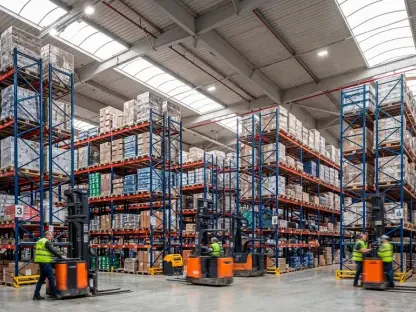Companies want faster and more cost-effective solutions to manage delivery and supply chain effectively, especially in today’s fast-paced commerce environment. AI integration is a step towards this. It helps organizations achieve their goals to fast-track delivery, streamline shipping processes, minimize expenses, and enhance customer satisfaction. The World Economic Forum confirms that early adopters of automation experience a 65% increase in supply chain optimization. This article explores how enterprises leverage AI to save time and money, and highlights strategies that can help you transform your operations while effectively managing resources and enhancing customer experiences.
Predict Estimated Delivery Dates
Delivery times critically impact customer experience and operations. When these times are poorly estimated, it leads to inefficiencies, damages customer relationships, increases costs, interrupts services, and causes delays. Globally, nearly 40% of customers reveal their desire to receive precise or close to accurate estimations on product delivery, stating that this information improves their experience. Even so, it is challenging for enterprises to manually predict delivery dates with 90% or more accuracy, leaving them susceptible to operational disturbances.
Introducing AI enables companies to elicit the support of machine learning and algorithmic tools when estimating dates. This approach provides a way to improve the accuracy of delivery predictions. Logistics companies use automation to receive data about the most probable date, helping them bypass prediction errors and enhancing customer service.
With AI tools, estimated delivery dates become a dynamic process that easily adjusts according to changing supply chain conditions and obstacles. It enables organizations to remain agile, using filtering and data representation to display points that fall within the desired delivery parameters, no matter how often they change. Having the correct data at their disposal allows operators to keep customers informed throughout the procurement and delivery processes, which leads to positive attitudes and relations.
Optimize Route Management
By integrating AI into operations, organizations can also plan the optimal route for deliveries before and during a delivery cycle. Route management helps logistics teams anticipate transport-related costs and achieve timely shipments. For example, planning ahead is the reason Amazon achieves same-day deliveries year-on-year to over 135 locations across Europe.
Any business can enjoy the same success as Amazon by incorporating AI. Smart algorithms are known to equip enterprises with the information needed to analyze transport patterns and factors in the order of priority, delivery window, road conditions, congestion, and capacity. This analysis helps to lessen idle time and accelerate delivery times.
Facilitate End-to-End Order Tracking
Depending on legacy systems to track and trace orders during delivery often creates siloed systems that make it difficult to connect supply chain networks. While legacy technology becomes a barrier to logistics, using AI creates a seamless connection between supply ecosystems. Automation allows operations to maximize modern tools, including APIs, radio-frequency identification, and IoT sensors, to facilitate end-to-end tracking.
AI-powered supply networks, such as warehouses, distribution centers, carriers, and retail outlets, provide a full view of the logistics chain for operational efficiency. This enables businesses to improve visibility for processes like quality checks, customs clearance, inventory control, and proof-of-delivery. By using modern technologies, organizations promote minute-by-minute order tracking until the product arrives at the customer’s address, which enables efficient supply chain management.
Plan Inventory for Future Demand
The machine learning and predictive analysis tools from AI enable inventory, management, and supply chain operational efficiency. These tools provide an effective way to interpret historical data and plan ahead for inventory. Demand forecasting is one of the most effective approaches to boosting sales and managing risk. It enables businesses to prepare for customer expectations, even as their preferences change.
Machine learning mechanisms can foresee long-term trends and short-term demand scenarios, enabling market predictions, so enterprises match their offerings to what consumers want. AI’s ability to provide predictive data enables cost reduction and sustains market competitiveness.
Streamline Shipping Tasks
Automation streamlines logistics to fast-track procurement and delivery. Without AI-powered tools, shipments would take an average of two and a half days to dispatch products. Slow shipping frustrates customers and reflects badly on businesses, especially since 74% of shoppers desire next-day delivery. This means supply chains cannot afford delays, which is why automation is important.
Modern solutions simplify shipping tasks to optimize operations, which include generating document trails and scheduling product pickups. Improving workflows with automation ensures that shipments are ready to be transported to customers within the desired time frame. This enables businesses to meet consumer needs and maximize efficiency.
Personalize Services
Customers gravitate towards services and messaging that’s tailored to their needs. Prioritizing personalization will help logistics companies customize their offerings and marketing campaigns based on the market. Using AI provides a purchase history that indicates what consumers want so that supply chains can supply it. This includes offering live tracking services that alert customers at every stage of their order journey to promote transparency and customer satisfaction.
Prevent Return to Origin Risks
On-time deliveries boost sales and encourage purchase behaviors. However, when businesses fail to deliver or experience delays during the process, it can lead to costly returns. With real-time tracking solutions, enterprises receive an overview of their processes, so they can solve issues that arise and communicate with the customer to prevent frustration.
Proactively alerting shoppers about their products prevents order cancellations, retaining supply chain revenue. Businesses maintain a competitive edge in the market by leveraging these powerful tools to enhance operational efficiency and customer satisfaction.
Final Thoughts
Well-organized logistics are a critical factor for operational success. Integrating AI-led automation within outlet and distribution networks enhances efficiency, accuracy, and customer satisfaction. It allows businesses to meet and exceed the evolving demands of today’s marketplace.
The potential of AI to transform supply logistics is immense. Adopting it into operations is becoming more crucial for business stability. AI streamlines operations, from route optimization to personalized customer interactions, ultimately reducing costs and improving delivery times. By embracing the strategies outlined above, companies position themselves as competitive market players, all while ensuring sustainable growth and operational excellence.









